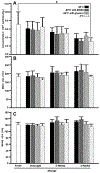Storage of Extracellular Vesicles in Human Milk, and MicroRNA Profiles in Human Milk Exosomes and Infant Formulas
- PMID: 31169664
- PMCID: PMC6658346
- DOI: 10.1097/MPG.0000000000002363
Storage of Extracellular Vesicles in Human Milk, and MicroRNA Profiles in Human Milk Exosomes and Infant Formulas
Abstract
The objectives of this study were to lay the methodological groundwork for field studies of microRNA analysis in exosomes from small sample volumes of human milk, and assess exosome and microRNA content in infant formulas. When human milk was stored at 4°C for 4 weeks, the count of exosome-sized vesicles decreased progressively to 49% ± 13% of that in fresh milk. Exosomes were purified from 1 mL of fresh human milk and their microRNA content was assessed by microRNA-sequencing analysis and compared with that in infant formulas. We identified 221 microRNAs in exosomes from 3 samples of fresh human milk; 84 microRNAs were present in all 3 samples. MicroRNAs were not detectable in infant formulas and their exosome-sized vesicles, which appeared to be casein micelles. We conclude that large-scale studies of microRNAs in human milk exosomes are feasible, and exosomes and microRNAs are not detectable in formulas.
Conflict of interest statement
Figures
References
-
- Zempleni J, Sukreet S, Zhou F, et al. Milk-Derived Exosomes and Metabolic Regulation. Annu Rev Anim Biosci 2018. (in press). - PubMed
Publication types
MeSH terms
Substances
Grants and funding
LinkOut - more resources
Full Text Sources
Other Literature Sources
Medical


